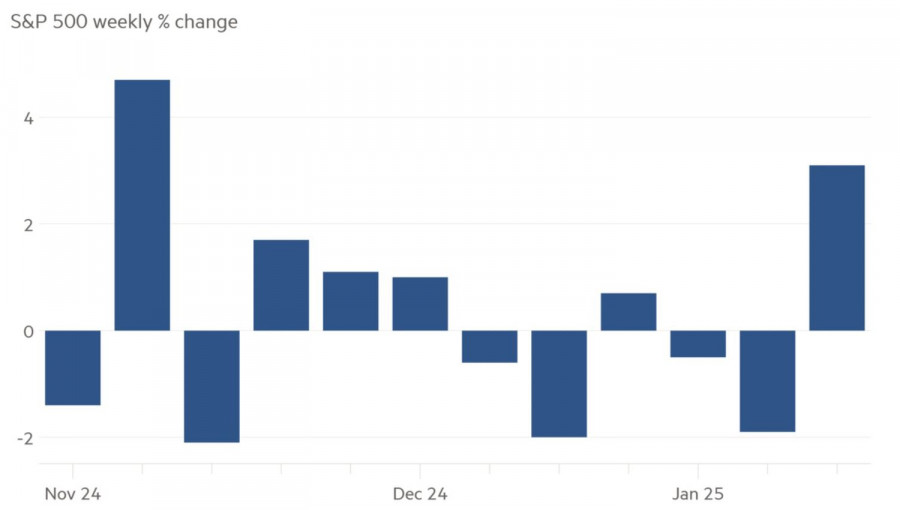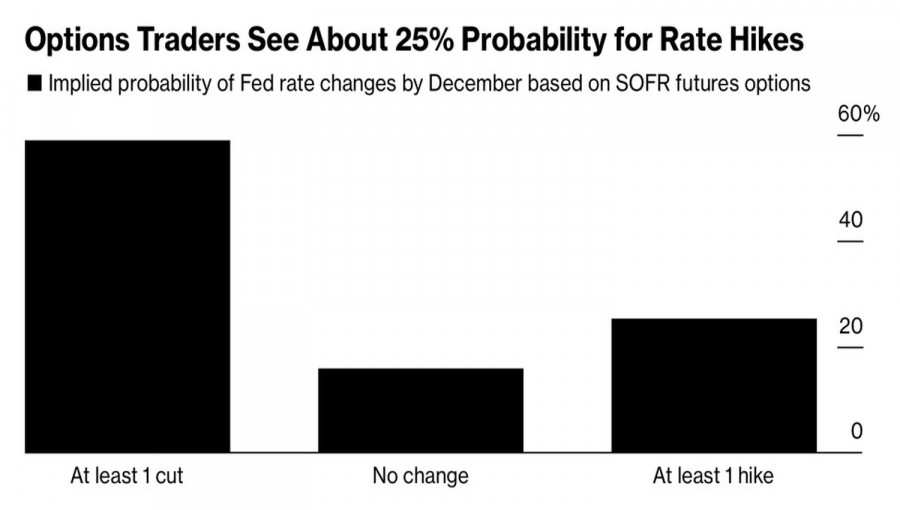Lihat juga


 20.01.2025 09:02 AM
20.01.2025 09:02 AMThe S&P 500 achieved its best weekly performance since the November U.S. presidential election, just before Donald Trump's inauguration. Initially, investors worried that his protectionist policies could negatively impact the U.S. economy. However, they now believe that the potential benefits from deregulation and fiscal stimulus will outweigh the drawbacks. Is this wishful thinking?
The broad market index surged by 4.7% during the week ending January 17, fueled by a strong start to the corporate earnings season and a 0.2% month-over-month decline in core inflation in the U.S. Major banks such as JP Morgan, Goldman Sachs, and Citigroup reported positive fourth-quarter earnings, alleviating investor concerns. The likelihood of the Federal Reserve refraining from rate cuts in 2025—or even increasing rates—has decreased, boosting confidence in two expected monetary easing actions this year. Federal Open Market Committee (FOMC) official Christopher Waller even suggested the possibility of easing monetary policy in March.
Bank of America suggests that U.S. equities could benefit from Donald Trump's return to the White House. During his first term, Trump viewed the performance of U.S. stock indices as a measure of his effectiveness, and it is unlikely that this perspective will change from 2025 to 2028. UBS Global Wealth Management estimates a 9% increase in corporate earnings this year, which could push the S&P 500 to 6,600.
According to Jefferies, since 1929, the S&P 500 has historically followed a zigzag pattern during presidential inaugurations, averaging gains of 8.3% and 9.5% six and twelve months, respectively, after a new president takes office.
In the early days of Trump's second term, investors will consider the impacts of tariffs and anti-immigration policies alongside the potential benefits of fiscal stimulus and deregulation. It appears that the new president may begin by implementing import tariffs, setting this term apart from his previous one.
During his term from 2017 to 2020, Trump stimulated the economy through tax cuts but later resorted to tariffs and trade wars, which ultimately slowed down growth. This time, the sequence may be reversed. Import tariffs are likely to accelerate inflation and hinder economic growth, even though the current outlook remains strong. For example, the IMF predicts that U.S. GDP will grow by 2.8% in 2024. Consequently, uncertainty regarding the Federal Reserve's policy stance could increase, with derivatives currently indicating a 25% probability of a federal funds rate hike.
On the daily chart, the market illustrated the principle: "If the market does not move as expected, it is likely to move in the opposite direction." After an unsuccessful attempt to break below the lower boundary of the triangle, the market successfully breached the upper boundary. A strong test of resistance at 6010 could justify expanding long positions that were initiated at 5930.
You have already liked this post today
* Analisis pasaran yang disiarkan di sini adalah bertujuan untuk meningkatkan kesedaran anda, tetapi tidak untuk memberi arahan untuk membuat perdagangan.
Pasaran telah mengambil kira sepenuhnya hasil rundingan antara AS dan China, yang membawa kepada gencatan senjata perdagangan selama 90 hari. Data ekonomi AS yang lebih lemah daripada jangkaan telah mengimbangi
Analisis Laporan Makroekonomi: Beberapa acara makroekonomi dijadualkan pada hari Jumaat, dan acara-acara tersebut tidak lebih penting daripada laporan yang dikeluarkan pada hari Khamis, yang tidak mencetuskan sebarang reaksi pasaran. Pada
Pasangan mata wang GBP/USD didagangkan secara mendatar pada hari Khamis dengan turun naik yang rendah tingkah laku tipikal bagi pound sepanjang bulan lalu. Mula-mula, terdapat julat mendatar klasik; kini, kita
Pasangan mata wang EUR/USD bergerak dalam kedua-dua arah pada hari Khamis, namun akhirnya kekal di bawah garisan purata pergerakan. Kedudukannya di bawah purata bergerak membolehkan kita menjangkakan pengukuhan lanjut dolar
Minggu lalu, Donald Trump mengumumkan penandatanganan perjanjian pertama dengan United Kingdom di bawah kempen "America's Liberation" beliau. Kemudian didedahkan bahawa perjanjian itu masih belum ditandatangani, dan rundingan mungkin memakan masa
Tinjauan bulanan NAB Business Survey menunjukkan bahawa momentum positif yang mendorong pertumbuhan KDNK sebanyak 1.3% y/y pada suku pertama kini semakin pudar. Keyakinan perniagaan meningkat sedikit namun masih berada dalam
Laporan pertumbuhan ekonomi UK yang dikeluarkan hari ini memberikan sokongan kepada pembeli GBP/USD, walaupun reaksi pasaran agak terbatas. Pedagang berasa keberatan untuk membuka kedudukan besar sebelum ucapan Pengerusi Rizab Persekutuan
Your IP address shows that you are currently located in the USA. If you are a resident of the United States, you are prohibited from using the services of InstaFintech Group including online trading, online transfers, deposit/withdrawal of funds, etc.
If you think you are seeing this message by mistake and your location is not the US, kindly proceed to the website. Otherwise, you must leave the website in order to comply with government restrictions.
Why does your IP address show your location as the USA?
Please confirm whether you are a US resident or not by clicking the relevant button below. If you choose the wrong option, being a US resident, you will not be able to open an account with InstaTrade anyway.
We are sorry for any inconvenience caused by this message.


